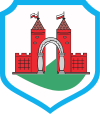Kłodawa
| Kłodawa | ||
|---|---|---|
|
Church of the Assumption of the Blessed Virgin Mary in Kłodawa, 18th century | ||
| ||
 Kłodawa | ||
| Coordinates: 52°15′2″N 18°54′56″E / 52.25056°N 18.91556°E | ||
| Country |
| |
| Voivodeship | Greater Poland | |
| County | Koło | |
| Gmina | Kłodawa | |
| Established | 11th century | |
| Town rights | 1430-1867, 1925 | |
| Government | ||
| • Mayor | Józef Chudy | |
| Area | ||
| • Total | 4.32 km2 (1.67 sq mi) | |
| Population (2014) | ||
| • Total | 6,699 | |
| • Density | 1,600/km2 (4,000/sq mi) | |
| Time zone | CET (UTC+1) | |
| • Summer (DST) | CEST (UTC+2) | |
| Postal code | 62-650 | |
| Area code(s) | +48 63 | |
| Car plates | PKL | |
| Website | http://klodawa.wlkp.pl | |
Kłodawa [kwɔˈdava] (German: Tonningen) is a town in central Poland with 6,699 inhabitants (2014). It is situated in the Greater Poland Voivodship (since 1999), having previously been in Konin Voivodship (1975–1998).
Kłodawa lies on the Rgielewka (a tributary of the Warta River). The town contains the largest operating salt mine in Poland, extracting halite and salts of potassium and magnesium.
Kłodawa was settled in the 11th century by craftsmen building the Church of St. Giles. It gained municipal rights in 1430. Much of the town was destroyed in the wars of the 17th century and World War II. It was once home to a vibrant Jewish community wiped out during the German occupation.[1] On the outskirts there is a cemetery from the Lusatian culture.
History
Four-thousand-year-old traces of settlements in the area of Kłodawa can be found in the nearby village of Słupeczka. Remains of the Lusatian culture, about 2500 years old, can be found in Old Kłodawa.
The settlement gained municipal rights on August 9, 1430 by the decree of King Władysław II Jagiełło. The town was badly damaged in the 1650s by the invading Swedes during “The Deluge”. Despite outside assistance, reconstruction took a very long time. Kłodawa was ruled by Prussia after the second partition of Poland in 1793. From 1806 until 1815, the town was part of the Duchy of Warsaw, and Congress Poland afterwards. In 1867, Kłodawa lost its municipal charter. After World War I it was returned to Poland and in 1925 regained its charter.
During the occupation by Germany during World War II, the town was renamed Tonningen (1940–1945). In 1941, more than 1500 Kłodawan Jews were killed by the Nazis in the Chelmno extermination camp. The Kłodawa parish priest, Father Teofil Choynowski, was killed in Dachau in 1943. Kłodawa was liberated on January 19, 1945 by the Red Army,
Notable residents
- Paweł Włodkowic of Brudzeń (c. 1370–1435)—medieval scholar and diplomat. Parish priest of the Church of St. Giles in Kłodawa, Retired here in 1424.
- Michał Rawita-Witanowski (1858–1943)—pharmacist, historian and ethnographer. Owned a pharmacy in Kłodawa. Wrote about the history of the region in several publications.
- Aaron Kozminski (1865–1919)—Identified as Jack the Ripper
- Andrzej Ruciński (born 1958)—member of Sejm
Distance and driving time to regional cities
- Koło—20 km (10 mi)—about 20 minutes
- Konin—50 km (30 mi)—about 45 minutes
- Włocławek—50 km (30 mi)—about 45 minutes
- Łódź—65 km (40 mi)— about 1 hours
- Toruń—110 km (70 mi)—about 1.5 hours
- Bydgoszcz—150 km (95 mi)—about 2 hours
- Poznań—150 km (95 mi)—about 2 hours
- Warsaw—150 km (95 mi)—about 2 hours
References
External links
| Wikimedia Commons has media related to Kłodawa. |
Coordinates: 52°15′N 18°55′E / 52.250°N 18.917°E

